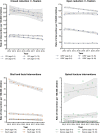Trends in hospital admissions for childhood fractures in England
- PMID: 34786491
- PMCID: PMC8587381
- DOI: 10.1136/bmjpo-2021-001187
Trends in hospital admissions for childhood fractures in England
Abstract
Purpose: Fractures to the axial and appendicular skeleton are common in children causing loss of opportunities and disability. There are relatively few studies available to quantify the number of children who have their fractures diagnosed in the emergency department and are then admitted to hospital for ongoing management. The purpose of this study is to explore trends of frequency, types and age of children sustaining fractures who were admitted for intervention to National Health Service (NHS) hospitals.
Design: The study uses data from the Hospital Episode Statistics and Office for National Statistics from 2012 to 2019 to calculate the annual incidence of hospital admission for limb, spine, facial and skull fractures per 100 000 children.
Results: During 2012-2019, 368 120 children were admitted to English NHS hospitals with a fracture. 256 008 (69.5%) were upper limb fractures, 85 737 (23.3%) were lower limb fractures and 20 939 (5.7%) were skull or facial fractures. The annual incidence of upper limb fractures was highest in children aged 5-9 (348.3 per 100 000 children) and the highest incidence of lower limb fractures was in children aged 10-15 (126.5 per 100 000 children). The incidence of skull and facial fractures in preschool (age 0-4) children has been increasing at a rate of 0.629 per 100 000 children per year.
Implications: The annual incidence of hospital admission for fractures in children has been shown to be consistent for several fracture types between 2012 and 2019. An increasing trend of admissions with preschool skull fractures was observed, though the study data do not have sufficient granularity to demonstrate if this is due to changes in practice or to accidental or non-accidental causes.
Keywords: epidemiology.
© Author(s) (or their employer(s)) 2021. Re-use permitted under CC BY. Published by BMJ.
Conflict of interest statement
Competing interests: None declared.
Figures


References
-
- Landin LA. Fracture patterns in children. Analysis of 8,682 fractures with special reference to incidence, etiology and secular changes in a Swedish urban population 1950-1979. Acta Orthop Scand Suppl 1983;202:1–109. - PubMed
-
- Kang MS, Kim H-S. Characteristics and trends of traumatic injuries in children visiting emergency departments in South Korea: a retrospective serial cross-sectional study using both nationwide-sample and single-institutional data. PLoS One 2019;14:e0220798. 10.1371/journal.pone.0220798 - DOI - PMC - PubMed
Publication types
MeSH terms
LinkOut - more resources
Full Text Sources
Medical
